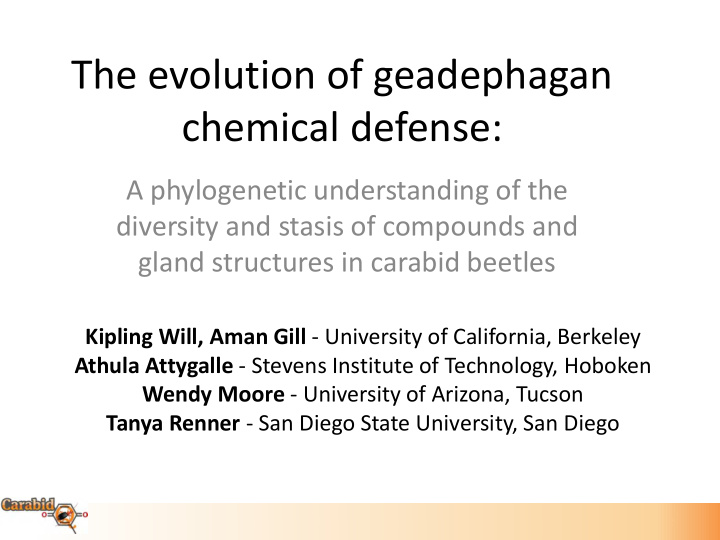



The evolution of geadephagan chemical defense: A phylogenetic understanding of the diversity and stasis of compounds and gland structures in carabid beetles Kipling Will, Aman Gill - University of California, Berkeley Athula Attygalle - Stevens Institute of Technology, Hoboken Wendy Moore - University of Arizona, Tucson Tanya Renner - San Diego State University, San Diego
Chemical defense Figure from Les Insectes , Hachette, Paris, 1883
Formica sp., Mt. Diablo, CA
Chemically defended Promecognathus laevissimus drives away Formica sp. ants, Mt. Diablo, CA
The bombardier beetle. Dramatic carabid beetle chemical defense made famous by Tom Eisner. Thomas Eisner Pherosophus image courtesy of the Institute of Physics
Diversity of quinone producers 1. Pherosophus sp 4. Chlaenius tricolor 2. Metrius contractus 3. Clivina fossor Images courtesy of (1) Thomas Eisner; (2,4) Alex Wild, & (3) Carabidae.Org
Related talks at ICE The evolution of Geadephagan chemical defense: Molecular evolution and functional validation of genes essential to quinone production in two Wendy Moore Tanya Renner bombardier beetle species using RNAi. Dr. Aman Gill U. of AZ San Diego State The Paussus L. (Carabidae: Paussinae ) of Madagascar: An explosive adaptive radiation of myrmecophilous beetles . Dr. James Robertson and Dr. Wendy Moore Molecular phylogeny of the flanged bombardier Athula Attygalle beetles (Carabidae: Paussinae) . Dr. Wendy Moore Aman Gill Stevens Inst. of UC Berkeley Technol. Hoboken The NSF funded Carabid Q project team
Project objectives: Telling the story of chemical defense of carabid beetles 1. Genetic basis of chemical production 2. Biosynthetic pathways leading to final products 3. Evolutionary transitions of compounds, pathways, and genes. 4. Environmental and selective correlates
Talk Outline • Brief background carabid beetle chemical defense • Structure of the gland system • Summary of knowledge and sampling for defensive chemicals in carabids • Phylogenetic distribution of selected chemical classes • Implications of a 2-phase system
Carabidae Worldwide 37,000 described species. All are thought to be chemically defended Random images from Google search
All Adephagan beetles have a pair of pygidial glands. Gland reservoirs may occupy 20-30% of the space in the abdomen. Replete defensive gland reservoirs Open abdomen, dorsal view of Platynus brunneomarginatus
The system of cells and ducts in P. brunneomarginatus
Close up of secretory cells from the formic acid producing P. brunneomarginatus
Current understanding of carabid defensive gland products • 545 species from across the family • covering 59 of the ~75 tribes • Approximately 250+ compounds • 18 classes of compounds
Carabidae Chemical Classes [species/tribes] I: Hydrocarbons [105/33] II: Ketones and non-Aromatic Aldehydes [66/14] III: Aliphatic Alcohols [10/9] IV: Esters [34/18] V: Formic Acid [161/27] VI: Higher Saturated Carboxylic Acids [183/34] VII: Unsaturated Carboxylic Acids [168/26] VIII: Phenols [33/3] IX: Aromatic Aldehydes [102/6] Psydrus piceus X: Aromatic Alcohols [2/2] Image, Joyce Gross XI: Aromatic Esters [13/12] XII: Aromatic Acids [2/2] XIII: Quinones [37/7] XIV: Sulfur Compounds [2/1] XV: Terpenes [6/4] XVI: Aromatic Ethers [1/1] XVII: Nitrogen Heterocyclic [2/2] XVIII: Cyanides [1/1] Nomius pygmaeus Classes in black from Moore (1979), in red newly recognized
Carboxylic Acids Unsaturated Complementary distribution of Hydrocarbons and Carboxylic Acids Hydrocarbons Higher Saturated Carboxylic Acids present absent Unk/Amb Adephaga ML tree from 6 gene analysis, D.R. Maddison, et al. unpubl. BToL data
Formic Acid Correlated distribution of Hydrocarbons with Formic Acid and Quinone Hydrocarbons Quinone present absent Unk/Amb Adephaga ML tree from 6 gene analysis, D.R. Maddison, et al. unpubl. BToL data
-A huge diversity of “ground beetles” are arboreal. -Arboreal habitat exposes them to predation. -Most arboreal species produce formic acid & hydrocarbons. Agra sp., Carabidae Maquipucuna reserve, Pichincha, Ecuador. Image by Alex Wild
One gland reservoir per gland the produce the same compounds Two phases occur together (aqueous/hydrophobic) Formic acid/Hydrocarbons Beetles live in a three dimensional habitat with lots of potential predators
The 2-phases are not miscible, but must be sprayed together (Hydrocarbons) (Formic Acid) (Hydrocarbons Formic Acid)
(Hydrocarbons) (Formic Acid) Dorsal Anterior Image of Platynus angustatus courtesy Igor Sokolov, LSU
(Hydrocarbons) (Formic Acid) Anterior Dorsal If the lipid phase floated to the top a climbing beetle would be disadvantaged
Tests suggest that Carabids spray a mix regardless of body orientation.
This does not happen! (Hydrocarbons) (Formic Acid) Anterior Dorsal If the lipid phase floated to the top a climbing beetle would be disadvantaged
Formic Acid A dorsal lobe on the reservoir in some taxa and at least one other mechanism in other taxa holds the lipid phase near the Hydrocarbons efferent duct. We don’t know how the second case works, yet.
Conclusions 1. Using formic acid with hydrocarbons as a defensive chemical mix was probably key for carabids to move into the canopy habitat, a factor driving the Harpalinae radiation. 2. In addition to these chemicals, there needs to be an effective storage and delivery system for a 2-phase admix. Carabids have evolved the dorsal lobe and at least one other undetermined mechanism to do this. 3. Our telling of the detailed story of chemical defense of carabid beetles is just beginning.
This project is supported by funding from the National Science Foundation, DEB1556957 DEB1556813, DEB1556931, DEB1556898
Recommend
More recommend